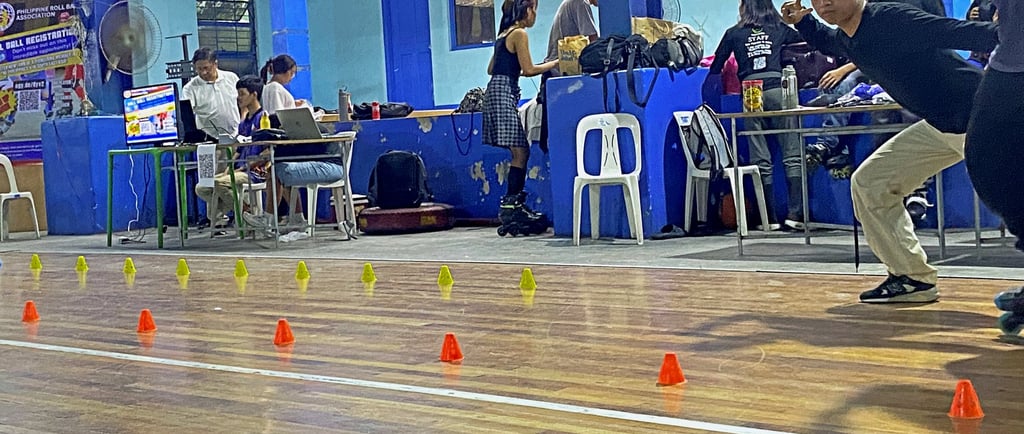10 Tips to Prepare for a Sliding Competition in Inline Skating for Men and Women
EDUCATIONAL
6/4/20241 min read


1. Selecting the Right Gear
Choosing the appropriate gear is crucial for success in a sliding competition in inline skating. The first and foremost consideration is selecting the right pair of inline skates. Opt for skates that are specifically designed for sliding, as they provide better control and stability. Ensure that the skates fit snugly but are not too tight, as ill-fitting skates can cause discomfort and hinder your performance. It is recommended to try on several pairs and consult with a professional if possible to find the best fit.
Protective gear is equally important when preparing for a sliding competition. A high-quality helmet is essential to protect your head in case of falls. Look for helmets that meet safety standards and offer a comfortable fit. Knee pads, elbow pads, and wrist guards are also necessary to safeguard against potential injuries. These pads should be durable yet flexible, allowing for a full range of motion while providing ample protection.
Additionally, gloves designed for inline skating can enhance your grip and control while sliding. Choose gloves that are breathable and have reinforced palms for added durability. It's important to remember that the right clothing can significantly impact your performance. Wear form-fitting, moisture-wicking attire that allows for optimal movement and comfort. Avoid loose clothing that could get caught in your skates or obstruct your movements.
Lastly, ensure that all your equipment is in good condition and properly maintained. Regularly inspect your skates, pads, and helmet for any signs of wear and tear. Replace any damaged or worn-out gear to prevent injuries and maintain top performance. Proper gear not only enhances your safety but also boosts your confidence, allowing you to focus on your technique and enjoy the competition.
Mastering Basic Techniques
Before participating in a sliding competition, it is imperative to master the fundamental skating techniques to ensure both safety and performance. The journey begins with adopting the proper stance. Maintaining a low center of gravity is key; this involves bending your knees and keeping your body slightly forward. This stance not only enhances balance but also facilitates smoother transitions between different maneuvers.
Balance is another critical aspect. Practicing balance exercises, such as one-legged stands or slow skating drills, can significantly improve stability. Weight distribution plays a pivotal role here. Properly shifting your weight from one foot to the other allows for more controlled movements, making it easier to execute slides with precision.
Once the basic stance and balance are mastered, attention should shift to foundational slides. The powerslide, for instance, is a vital technique in any skater's repertoire. This slide involves a sudden 180-degree turn where one foot is used to brake and the other to steer. Begin by practicing the powerslide at a slow pace, gradually increasing speed as confidence builds. Another essential slide is the parallel slide, where both feet are positioned parallel to each other, and the skater slides sideways to come to a halt. This slide requires meticulous control of weight distribution and edge work.
Regular practice of these basic slides is crucial. Set aside time to repeatedly perform these moves in a controlled environment, such as a skate park or a smooth, open space. Incorporating these exercises into your routine will help in honing the skills necessary for more advanced techniques. Remember, consistency and patience are key to mastering these foundational elements. With dedication and practice, the transition to more complex slides and maneuvers will become significantly smoother.
Building Strength and Endurance
Strength and endurance are cornerstone attributes for excelling in any competitive sport, and inline skating is no exception. To perform at your best during a sliding competition, it's essential to focus on exercises and training routines that target the specific muscle groups used in inline skating. These primarily include the quadriceps, hamstrings, glutes, and calf muscles.
A well-rounded strength training program should incorporate exercises such as squats, lunges, and leg presses. Squats are particularly effective as they engage multiple muscle groups simultaneously, enhancing overall leg strength. Lunges, on the other hand, improve balance and coordination while targeting the glutes and hamstrings. Leg presses provide an excellent way to build power in the lower body, which is crucial for explosive movements during skating.
Additionally, don't overlook the importance of core strength. A strong core provides stability and balance, which are vital for maintaining control during intricate maneuvers. Exercises like planks, Russian twists, and leg raises can significantly improve core stability. Upper body strength is also important; incorporate push-ups, pull-ups, and dumbbell rows to ensure you have the strength to maintain proper posture and control.
Endurance is equally critical for sustaining high performance throughout the competition. Cardiovascular fitness can be enhanced through aerobic exercises like running, cycling, and swimming. Incorporate these activities into your training regimen at least three times a week to build stamina. High-Intensity Interval Training (HIIT) is another effective method to boost cardiovascular endurance in a shorter time frame. Alternating between periods of intense activity and rest can simulate the bursts of speed and recovery you experience during a race.
Lastly, consistency is key. Regularly scheduled training sessions, balanced with adequate rest and recovery, will ensure that you build both strength and endurance over time. By integrating these exercises and routines into your preparation, you'll be well-equipped to handle the physical demands of a sliding competition in inline skating.
Developing Advanced Sliding Skills
After mastering the basic techniques of inline skating, the next step is to develop advanced sliding skills. These skills are crucial for anyone looking to compete at a higher level and can significantly enhance overall performance. Among the most essential advanced maneuvers are the backward slide, cross-slide, and combo slides. Understanding and practicing these techniques will not only improve your sliding proficiency but also add versatility to your competition routine.
The backward slide is a fundamental advanced skill that requires skaters to glide backward while maintaining control and balance. Start by practicing on a flat surface and gradually transition to more challenging terrains. Key tips for executing a backward slide include keeping your knees slightly bent, maintaining a low center of gravity, and using your arms for balance. Safety gear is non-negotiable during practice to prevent injuries.
Another critical maneuver is the cross-slide, which involves crossing one foot over the other while sliding. This technique demands a higher level of coordination and balance. Begin by learning the motion at a slower pace, focusing on smooth, controlled movements. As you gain confidence, increase your speed and incorporate the cross-slide into more dynamic sequences. Regular drills and consistent practice are essential for mastering this skill effectively.
Combo slides, which integrate multiple slide techniques into a single fluid motion, are highly effective in competitions. These combinations can include sequences like transitioning from a backward slide to a cross-slide. To practice combo slides, break down each component and master them individually before attempting to combine them. Use cones or markers to create practice courses that simulate competition settings, allowing you to refine your technique under realistic conditions.
When practicing advanced sliding skills, it is crucial to prioritize safety. Always wear the appropriate protective gear, including helmets, knee pads, and wrist guards. Additionally, consider practicing with a coach or experienced skater who can provide guidance and feedback. Integrating these advanced maneuvers into your competition routine will not only showcase your skills but also enhance your overall performance in inline skating competitions.
5. Mental Preparation and Focus
Mental preparation plays a crucial role alongside physical training in competitive sports, particularly in a demanding discipline like inline skating. Developing mental resilience and focus can significantly enhance performance during a sliding competition. One effective technique to maintain focus and build confidence is through visualization exercises. By mentally rehearsing the movements and scenarios, skaters can create a mental blueprint of their performance. This practice helps in ingraining the sequences and increases familiarity with the competition environment, reducing anxiety and boosting confidence.
Mindfulness practices are another valuable tool for mental preparation. Incorporating mindfulness into daily routines can help skaters stay present and manage stress more effectively. Techniques such as deep breathing, progressive muscle relaxation, and meditation can calm the mind and body, promoting a state of focused relaxation. These practices enable skaters to maintain their composure and react swiftly to changing conditions during the competition.
Handling competition stress is an inevitable part of any sport. It’s essential to develop strategies to stay calm under pressure. Setting realistic goals and maintaining a positive mindset can be highly beneficial. Instead of fixating on the outcome, skaters should focus on their process and effort. This shift in perspective can alleviate pressure and enhance performance. Additionally, having a pre-competition routine can provide a sense of control and stability. This routine might include listening to calming music, engaging in light stretching, or reviewing key techniques.
Engaging in positive self-talk is another effective method to manage stress and enhance focus. Encouraging oneself with affirmations and constructive thoughts can build self-belief and reduce self-doubt. Recognizing and countering negative thoughts with positive ones cultivates mental resilience. By integrating these mental preparation techniques, skaters can approach competitions with a balanced mindset, ready to perform at their best.
Nutrition and Hydration
Proper nutrition and hydration play a critical role in optimizing performance for inline skaters participating in sliding competitions. A well-balanced diet and adequate fluid intake are essential for sustaining energy levels, enhancing endurance, and promoting recovery.
Before training sessions or competitions, it is important to consume a meal that balances carbohydrates, proteins, and fats. Carbohydrates are the primary source of energy for high-intensity activities, so including complex carbs such as whole grains, fruits, and vegetables will provide sustained energy. Proteins, found in lean meats, fish, eggs, and legumes, are essential for muscle repair and growth, while healthy fats from sources like nuts, seeds, and avocados support overall health and endurance.
Hydration should never be overlooked. Water is vital for maintaining fluid balance and regulating body temperature. It is recommended to drink water consistently throughout the day and increase intake before physical activity. During training or competitions, sports drinks containing electrolytes can help replenish lost minerals and maintain hydration levels. Avoiding excessive caffeine and sugary drinks is advisable, as they can lead to dehydration.
During the activity, quick energy sources such as energy bars, bananas, or gels can provide a necessary boost. Skaters should listen to their bodies and hydrate as needed, paying attention to signs of dehydration like dizziness or fatigue.
Post-activity nutrition is equally important for recovery. Consuming a meal or snack rich in proteins and carbohydrates within 30-60 minutes after exercise can aid in muscle recovery and glycogen replenishment. Foods like grilled chicken with quinoa, a smoothie with protein powder and fruits, or a yogurt with berries and nuts are excellent choices. Additionally, continued hydration post-exercise supports overall recovery and well-being.
Incorporating specific supplements can also be beneficial. Omega-3 fatty acids, found in fish oil, can reduce inflammation, while magnesium helps with muscle relaxation and recovery. However, skaters should consult with a healthcare professional before starting any supplement regimen to ensure it aligns with their individual needs and health status.
Contacts
information@skateshop.cc
Socials
Subscribe to our newsletter
Links
Shop Links
